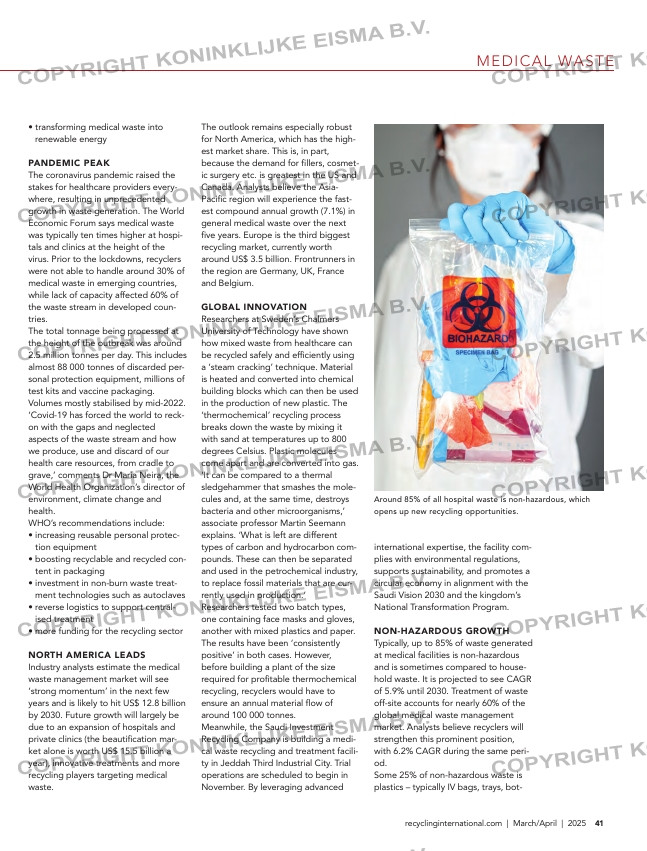Page 41 from: March/April issue 2025

41recyclinginternational.com | March/April | 2025
MEDICAL WASTE
The outlook remains especially robust
for North America, which has the high-
est market share. This is, in part,
because the demand for fillers, cosmet-
ic surgery etc. is greatest in the US and
Canada. Analysts believe the Asia-
Pacific region will experience the fast-
est compound annual growth (7.1%) in
general medical waste over the next
five years. Europe is the third biggest
recycling market, currently worth
around US$ 3.5 billion. Frontrunners in
the region are Germany, UK, France
and Belgium.
GLOBAL INNOVATION
Researchers at Sweden’s Chalmers
University of Technology have shown
how mixed waste from healthcare can
be recycled safely and efficiently using
a ‘steam cracking’ technique. Material
is heated and converted into chemical
building blocks which can then be used
in the production of new plastic. The
‘thermochemical’ recycling process
breaks down the waste by mixing it
with sand at temperatures up to 800
degrees Celsius. Plastic molecules
come apart and are converted into gas.
‘It can be compared to a thermal
sledgehammer that smashes the mole-
cules and, at the same time, destroys
bacteria and other microorganisms,’
associate professor Martin Seemann
explains. ‘What is left are different
types of carbon and hydrocarbon com-
pounds. These can then be separated
and used in the petrochemical industry,
to replace fossil materials that are cur-
rently used in production.’
Researchers tested two batch types,
one containing face masks and gloves,
another with mixed plastics and paper.
The results have been ‘consistently
positive’ in both cases. However,
before building a plant of the size
required for profitable thermochemical
recycling, recyclers would have to
ensure an annual material flow of
around 100 000 tonnes.
Meanwhile, the Saudi Investment
Recycling Company is building a medi-
cal waste recycling and treatment facili-
ty in Jeddah Third Industrial City. Trial
operations are scheduled to begin in
November. By leveraging advanced
international expertise, the facility com-
plies with environmental regulations,
supports sustainability, and promotes a
circular economy in alignment with the
Saudi Vision 2030 and the kingdom’s
National Transformation Program.
NON-HAZARDOUS GROWTH
Typically, up to 85% of waste generated
at medical facilities is non-hazardous
and is sometimes compared to house-
hold waste. It is projected to see CAGR
of 5.9% until 2030. Treatment of waste
off-site accounts for nearly 60% of the
global medical waste management
market. Analysts believe recyclers will
strengthen this prominent position,
with 6.2% CAGR during the same peri-
od.
Some 25% of non-hazardous waste is
plastics – typically IV bags, trays, bot-
Around 85% of all hospital waste is non-hazardous, which
opens up new recycling opportunities.
• transforming medical waste into
renewable energy
PANDEMIC PEAK
The coronavirus pandemic raised the
stakes for healthcare providers every-
where, resulting in unprecedented
growth in waste generation. The World
Economic Forum says medical waste
was typically ten times higher at hospi-
tals and clinics at the height of the
virus. Prior to the lockdowns, recyclers
were not able to handle around 30% of
medical waste in emerging countries,
while lack of capacity affected 60% of
the waste stream in developed coun-
tries.
The total tonnage being processed at
the height of the outbreak was around
2.5 million tonnes per day. This includes
almost 88 000 tonnes of discarded per-
sonal protection equipment, millions of
test kits and vaccine packaging.
Volumes mostly stabilised by mid-2022.
‘Covid-19 has forced the world to reck-
on with the gaps and neglected
aspects of the waste stream and how
we produce, use and discard of our
health care resources, from cradle to
grave,’ comments Dr Maria Neira, the
World Health Organization’s director of
environment, climate change and
health.
WHO’s recommendations include:
• increasing reusable personal protec-
tion equipment
• boosting recyclable and recycled con-
tent in packaging
• investment in non-burn waste treat-
ment technologies such as autoclaves
• reverse logistics to support central-
ised treatment
• more funding for the recycling sector
NORTH AMERICA LEADS
Industry analysts estimate the medical
waste management market will see
‘strong momentum’ in the next few
years and is likely to hit US$ 12.8 billion
by 2030. Future growth will largely be
due to an expansion of hospitals and
private clinics (the beautification mar-
ket alone is worth US$ 15.5 billion a
year), innovative treatments and more
recycling players targeting medical
waste.
40-41-43_medicalwaste.indd 41 06-03-2025 12:14



